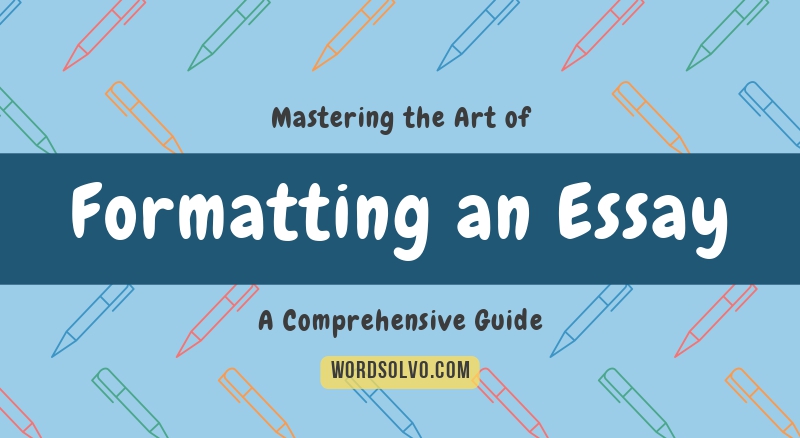Introduction
Formatting an essay is a crucial aspect of academic writing that often receives less attention than the content itself. However, adhering to specific guidelines, such as the formatting of an academic essay, is essential for conveying information clearly and professionally. In this comprehensive guide, we will explore the intricacies of formatting essays, covering the format of an academic essay and highlighting the nuances of formatting an essay MLA and formatting an APA paper.
The Format of an Academic Essay
Understanding the Basics
Before delving into the specific guidelines for different formatting styles, it's essential to grasp the fundamental elements that constitute the format of an academic essay. An academic essay typically includes an introduction, body paragraphs, and a conclusion. Each of these sections serves a unique purpose in presenting and supporting the main argument.
The introduction sets the stage for the essay, providing context and outlining the thesis statement. Body paragraphs delve into specific points or arguments, supported by evidence and analysis. Finally, the conclusion summarises the key points and reinforces the thesis, leaving a lasting impression on the reader.
Consistency and Clarity
Consistency is paramount in the format of an academic essay. This applies to the font, spacing, and margins throughout the document. Most academic essays use a standard font such as Times New Roman or Arial, with a size of 12 points. Double-spacing is often preferred, but specific guidelines may vary depending on the formatting style.
Maintaining a clear and readable font ensures the essay is accessible to a broad audience. Proper spacing and margins also contribute to a visually appealing and professional-looking document.
Formatting an Essay MLA Style
The Modern Language Association (MLA) style is widely used in the humanities, especially in literature and language studies. When formatting an essay MLA, several key elements must be considered to meet the style's requirements.

Title and Heading
In an MLA-formatted essay, the title is centred at the top of the first page, followed by the heading. The heading includes the author's name, instructor's name, course title, and the date, each on a separate line and aligned to the left. This information provides essential context about the essay's origin.

In-Text Citations
One hallmark of formatting an essay MLA style is the use of in-text citations to credit sources within the text. Author-page citations are typically enclosed in parentheses and placed at the end of the relevant sentence. Additionally, a Works Cited page at the end of the essay provides a comprehensive list of all sources cited in the essay, arranged alphabetically.
Page Numbers
Page numbers are another critical element when formatting an essay MLA style. Page numbers are typically placed in the header of each page, aligned to the right. This aids readers in navigating the document and allows for easy cross-referencing.
Formatting an APA Paper
The American Psychological Association (APA) style is commonly used in the social sciences, including psychology, sociology, and education. Formatting an APA paper requires attention to specific details that distinguish it from other styles.

Title Page and Running Head
An APA-formatted essay begins with a title page that includes the title of the paper, the author's name, institutional affiliation, and an author note if applicable. Additionally, a running head is included on each page, providing a concise version of the title for identification purposes.
Abstract and Headings
For longer essays or research papers, an abstract may be required in an APA paper. The abstract provides a brief summary of the essay's main points. Headings in an APA paper follow a hierarchical format, with different levels indicating various essay sections. This structure enhances the organisation and clarity of the content.
Citations and References
Similar to MLA, formatting an APA paper necessitates in-text citations. However, APA uses a different format, incorporating the author's name and the publication year. The references page, located at the end of the essay, provides a comprehensive list of all sources cited, arranged alphabetically by the author's last name.
Consistency Across Styles
While the specific guidelines for formatting an essay MLA and formatting an APA paper differ, certain principles remain constant across styles. Consistency in formatting, citation styles, and overall structure is crucial for producing a polished and professional academic document.
Proofreading and Revision
After completing the initial draft of an essay, it is imperative to proofread and revise the document thoroughly. This process goes beyond checking for grammatical errors and includes a meticulous review of formatting elements. Attention to detail during this stage ensures that the final document meets the prescribed guidelines and presents a unified and coherent appearance.
Utilising Style Guides
Both the Modern Language Association and the American Psychological Association publish comprehensive style guides that provide detailed instructions on formatting an essay MLA or formatting an APA paper. These guides cover everything from the placement of commas to the formatting of tables and figures. Consulting these resources can help writers navigate the intricacies of each style and produce essays that meet academic standards.
Conclusion
In conclusion, mastering the art of formatting an essay is an integral skill for academic success. Understanding the format of an academic essay, whether adhering to the formatting of an APA paper or formatting an essay MLA style, is essential for conveying ideas clearly and professionally. By maintaining consistency, clarity, and attention to detail, writers can produce essays that showcase their intellectual prowess and adhere to the highest standards of academic integrity. As students and scholars navigate the complexities of various formatting styles, embracing these guidelines ensures that their work is intellectually robust and visually polished.

